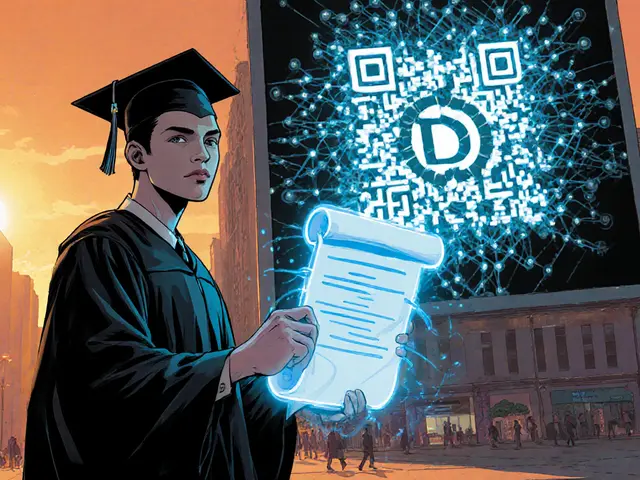Imagine proving you have a university degree, a driver’s license, or membership in a professional guild without ever sending a scan of a paper document or asking the issuing school to respond. Verifiable Credentials paired with Decentralized Identifiers (DIDs) make that scenario a reality. This guide walks you through what the tech looks like, how it works under the hood, and what you can actually do with it today.
Quick Take (TL;DR)
- VCs are tamper‑evident digital attestations that anyone can verify without contacting the issuer.
- DIDs are permanent, cryptographically‑protected IDs that live on a decentralized network.
- Three core roles: Issuer, Holder, and Verifier.
- Proof methods range from simple digital signatures to advanced zero‑knowledge proofs for selective disclosure.
- Revocation is handled via status lists, blockchain anchoring, or centralized revocation registries.
What are Verifiable Credentials?
A Verifiable Credential (VC) is a structured digital statement about an entity-person, organization, or device. The W3C Verifiable Credentials Data Model v2.0 defines three parts: the issuer, the credential subject (the thing being described), and a proof (a cryptographic element that proves authenticity).
Because the proof is mathematically tied to a public key, anyone can check the signature without calling the issuer. That’s why VCs are called “verifiable”: the credential’s integrity and provenance can be independently confirmed.
Enter Decentralized Identifiers (DIDs)
A DID is a globally unique identifier that resolves to a DID Document. The document holds the public keys and service endpoints needed to interact with the DID owner. Unlike a URL, a DID never points to a centralized server; it lives on a Verifiable Data Registry (VDR) such as a blockchain, IPFS+PubSub, or a permissioned ledger.
There are many DID Methods-the protocol that defines how a DID is created and resolved. The most common today are did:key, did:web, and did:ion. Each method balances trade‑offs between ease of use, privacy, and scalability.
Five‑Layer Architecture of VC+DID Systems
The overall stack splits into five logical layers, each with a clear responsibility:
- Data Model Layer: W3C VC schema (JSON‑LD or JWT) that describes credential fields, types, and context.
- Identity Layer: DIDs and DID Documents that give every actor a cryptographically‑secure ID.
- Credential Issuance Layer: Formats (JSON‑LD for rich semantics, JWT for lightweight web integration) used to package the VC.
- Proof Layer: Digital signatures, Linked Data Proofs, or Zero‑Knowledge Proofs that enable selective disclosure.
- Revocation Layer: Mechanisms like Status Lists (on‑chain bitmaps), blockchain anchoring, or traditional CRL‑style services.
How a VC is Issued, Stored, and Presented
The end‑to‑end flow can be broken down into three steps:
- Issuance: The Issuer creates a VC, signs it with a private key linked to its DID, and sends the credential (or a reference) to the Holder’s wallet.
- Storage: The holder stores the VC locally (in a mobile wallet) or in a decentralized storage system (e.g., IPFS). The credential’s status can be tracked via a Status List entry on a blockchain.
- Presentation: When a Verifier asks for proof, the holder builds a presentation-a bundle that may contain the full VC or just a subset of claims. Advanced proof methods let the holder reveal “I am over 18” without exposing the birth date.
The verifier checks the proof, resolves the issuer’s DID to obtain the public key, and validates the credential’s status. If everything lines up, the verifier can trust the claim without ever contacting the issuer directly.
Proof Techniques: From Simple Signatures to ZKPs
Most early VCs use a straightforward digital signature (e.g., Ed25519). The signature covers the entire credential payload, making any alteration instantly detectable.
For privacy‑sensitive scenarios, Selective Disclosure is essential. Linked Data Proofs allow the holder to sign only the revealed bits, while zero‑knowledge proofs (ZKPs) can mathematically prove a statement (like “age≥21”) without revealing the underlying data. Frameworks such as Hyperledger Aries already provide ready‑made ZKP modules for common claim types.

Revocation Strategies
Unlike paper certificates that can be torn up, a digital credential lives forever unless you actively mark it as revoked. Common revocation patterns include:
- Status List 2021: A compact bitmap stored on‑chain; each bit corresponds to a credential’s revocation state.
- Blockchain Anchoring: The issuer embeds a hash of the credential in a transaction; a new transaction marks it as revoked.
- Centralized Revocation List: A traditional HTTP endpoint that returns a list of revoked IDs-useful for private consortia.
Choosing the right method depends on latency requirements, privacy concerns, and the trust model of the ecosystem.
Real‑World Use Cases
Below are some concrete scenarios where VC+DID solutions are already being piloted:
- Digital Passports: Travelers store a VC containing visa status, vaccination record, and biometric hash. Border control scanners verify the proof on the spot.
- Academic Credentials: Universities issue degree VCs. Employers query the holder’s wallet and instantly confirm authenticity.
- Membership Proofs: Clubs issue a VC that proves membership without revealing personal data, enabling private access to events.
- KYC/AML Compliance: Financial institutions accept a VC that confirms a user’s verified email and phone number, reducing onboarding friction.
- IoT Device Identity: Sensors carry a DID‑linked VC confirming firmware version and hardware provenance, usable for secure data pipelines.
Comparing Popular DID Methods
| Method | Storage | Privacy | Ease of Use | Typical Use Cases |
|---|---|---|---|---|
did:key | Self‑contained (no on‑chain) | High (no linking) | Very easy - generate locally | Developer testing, short‑lived IDs |
did:web | HTTPS server under a domain | Medium (domain ownership traceable) | Easy - no blockchain needed | Corporate branding, public services |
did:ion | Bitcoin‑based Sidetree network | High (decentralized ledger) | Moderate - requires ION client | Large‑scale SSI deployments |
did:keri | Merkle‑tree based, offline capable | Very high (supports rotation) | Complex - needs KERI library | High‑security government IDs |
Challenges and Adoption Barriers
Despite the technical elegance, several practical hurdles slow down widespread use:
- Ecosystem Fragmentation: Different wallets support different DID methods and proof types, causing compatibility headaches.
- User Experience: Managing private keys still feels “too technical” for everyday people. Wallets need smoother onboarding flows.
- Regulatory Uncertainty: Many jurisdictions lack clear guidance on legal recognition of VCs, especially for KYC.
- Scalability of Revocation: On‑chain status lists can become large; off‑chain solutions must retain trust.
Industry groups like the W3C Credentials Community Group and Hyperledger are actively addressing these gaps through standard updates, reference implementations, and pilot programs.
Future Directions
Looking ahead to 2026 and beyond, three trends will shape the landscape:
- Zero‑Knowledge Proofs at Scale: New libraries (e.g., zk‑SNARKs optimized for mobile) will let holders prove complex statements without any data leakage.
- Embedded Wallets: Mobile OSs are experimenting with system‑level SSI wallets, making key management invisible to the user.
- Policy Integration: Governments are drafting laws that formally recognize VCs for driver’s licenses and social benefits, turning pilots into national programs.
Quick Implementation Checklist
- Choose a DID method that matches your privacy and scalability needs.
- Define your VC schema (use existing W3C contexts where possible).
- Pick a proof format-digital signature for simple cases, ZKP for privacy‑heavy scenarios.
- Set up a revocation strategy (status list on a public blockchain is a good default).
- Integrate a wallet SDK (e.g., Aries Framework‑JavaScript) to handle issuance and presentation.

Frequently Asked Questions
What is the difference between a VC and an NFT?
Both are cryptographically verifiable, but a VC is a credential about an identity claim (e.g., a degree) and does not require on‑chain storage. An NFT is a unique token that lives on a blockchain primarily for ownership and scarcity; it may embed a VC but its core purpose differs.
Do I need a blockchain to use DIDs?
Not always. Methods like did:key are completely off‑chain, while others (e.g., did:ion) leverage a blockchain for decentralized resolution. Choose the method that fits your trust model.
How does revocation work without a central authority?
Revocation is expressed as a status entry linked to the credential’s identifier. The status list can be a compact bitmap stored on a public ledger, allowing anyone to verify revocation status without contacting the issuer.
Can I present only part of a VC?
Yes. Using selective disclosure or ZKPs, the holder can create a presentation that reveals just the needed claim (e.g., age) while keeping other fields hidden.
Are VCs legally recognized?
Legal status varies by jurisdiction. Some countries (e.g., Estonia) accept digital identity credentials under e‑Residency laws, while others are still drafting regulations. Always check local compliance before using VCs for official purposes.



tim nelson
September 26 2025First off, the notion of keeping private keys on a mobile device still feels a bit risky for most users. That's why I think we need wallet designs that abstract the cryptography away while still giving users control.
Zack Mast
September 28 2025One could argue that the very act of abstracting away security is a surrender to the surveillance state, a subtle erosion of sovereignty that masquerades as convenience. The true freedom lies in owning the key, not in outsourcing trust to some corporate‑run wallet.
Dale Breithaupt
September 30 2025Here’s a quick tip for anyone just getting started: pick a DID method that matches the scale of your project. If you’re prototyping, did:key gives you instant results without any blockchain hassle. For production, did:ion offers decentralized resolution without the overhead of managing a full node.
Rasean Bryant
October 3 2025You’ve nailed the practical advice-keeping it simple at first really lowers the barrier. Once the basics are solid, extending to richer proof types like selective disclosure feels much more natural.
Angie Food
October 5 2025Honestly, most of this hype is just buzzwords with no real impact.
Jonathan Tsilimos
October 7 2025The implementation paradigm for Verifiable Credential ecosystems necessitates a bifurcated architecture wherein the data model layer interoperates with a cryptographically verifiable identity substrate. Specification conformance to W3C VC Data Model v2.0 ensures semantic fidelity across heterogeneous presentations. Moreover, the adoption of JSON‑LD contexts facilitates semantic linkage whilst preserving compactness. In practice, the issuance pipeline should instantiate a credential schema, bind it to an issuer DID, and apply a Linked Data Proof or JWT signature contingent upon the verifier’s trust framework. Revocation mechanisms must be operationalized via Status List 2021 bitmaps to guarantee on‑chain integrity without imposing prohibitive latency. Consequently, system designers are urged to provision a modular SDK that abstracts these concerns whilst exposing configurable proof suites. This approach mitigates vendor lock‑in and accelerates integration timelines.
jeffrey najar
October 9 2025Good points on modular SDKs-I've seen that pattern cut integration time in half for my team. Adding a thin abstraction over the proof layer lets us swap between Ed25519 signatures and ZKPs without touching the core wallet code.
Rochelle Gamauf
October 12 2025While the foregoing exposition offers a respectable overview, it regrettably omits a critical discourse on the sociopolitical ramifications of decentralized identity. The techno‑optimism pervasive in most whitepapers overlooks the fact that unregulated DID proliferation may exacerbate surveillance capitalism under the guise of user empowerment.
Jerry Cassandro
October 14 2025That’s a fair critique; however, empirical pilots in the EU demonstrate that regulated DID frameworks can coexist with privacy safeguards when overseen by accountable data trusts.
Parker DeWitt
October 16 2025🔥🚀 Let’s be real-if we don’t lock down our own identities, foreign actors will! The only way to stay ahead is to own every credential and never let a centralized gatekeeper dictate access. 🇺🇸💪
Allie Smith
October 19 2025Interesting perspective-philosophically speaking, identity is a narrative we construct, and decentralized tools merely give us new chapters to write without external editors.
Lexie Ludens
October 21 2025Enough with the technical jargon! This whole VC hype is just a circus, and nobody’s buying tickets.
Aaron Casey
October 23 2025From a cross‑cultural standpoint, the terminology around Self‑Sovereign Identity can be intimidating, but framing it as “digital passport” often resonates better in non‑technical communities. When you align the DID concept with familiar notions of citizenship, adoption curves improve dramatically.
Leah Whitney
October 26 2025Exactly-contextualizing the tech in everyday language bridges the gap between developers and end‑users, especially in regions where digital literacy varies widely.
Lisa Stark
October 28 2025What we are witnessing is a paradigmatic shift in how societies conceive of trust. Historically, trust was mediated by physical artifacts-paper diplomas, embossed IDs, notarized seals. Those artifacts derived legitimacy from the authority that issued them, often a sovereign state or a recognized institution. Verifiable Credentials invert this model by embedding legitimacy directly into the data structure, cryptographically tethered to a decentralized identifier. This move dissolves the monopoly of the issuer, democratizing verification in a way that was previously unimaginable. Yet, the removal of central arbiters raises profound questions about accountability: if a credential can be verified without an issuer’s live consent, who bears responsibility for misuse? Moreover, the very notion of “self‑sovereignty” presupposes a level of digital hygiene that many users lack, potentially creating a new class of disenfranchised individuals who cannot manage their own keys. The technology also challenges existing regulatory frameworks, which are built around central verification points and audit trails. In the long term, we may see a hybrid model emerge, where decentralized verification coexists with optional custodial services that provide safety nets for the less technically inclined. Such an ecosystem would preserve the privacy benefits of SSI while mitigating the risks of accidental key loss. Ultimately, the success of this transformation will hinge not only on technical robustness but on societal willingness to reimagine identity itself as a fluid, portable datum rather than a static, state‑issued badge.
Logan Cates
October 30 2025Sure, but don’t forget the hidden backdoors that every “open” protocol inevitably carries.
Shelley Arenson
November 2 2025🤝 I hear you, but many projects are now implementing transparent audits to combat exactly that concern.
Joel Poncz
November 4 2025All in all, the tech is promising but we gotta keep it real and make sure real people can actually use it without becoming crypto‑geeks.